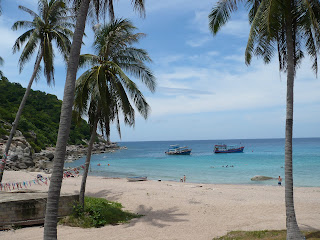We’ve finally reached Thailand, the shining star of Southeast Asia. It took a lot to get us here, since we travelled one of the most infamous overland crossings in the region. We took an early taxi to the Cambodian border town of Poipet (2 hours), passed through Cambodian immigration, walked through No Man’s Land between Cambodia and Thailand (i.e. a bunch of seedy casinos), got through Thai immigration, then booked a 4 hour mini-bus to Bangkok. It was a long day, but overland travel is always an adventure.
Arriving in Bangkok was a bit of a shock since the places we’d been travelling were far smaller and had fewer tourists. We took a cab to Soi Rambuttri, a street very close to the infamous backpacker ghetto of Khao San Road, and found a guesthouse to stay in for the next few days. It might be hard for us to give a fair assessment of the city, since we only spent three days in Bangkok (which most people we met along the way said was more than enough time). It is even more difficult to judge the city since the circus of Khao San Road dominates the tourist scene, but is not at all reflective of the “real” Bangkok. While it wasn’t our favourite city, we still had a good time, and we able to enjoy some Western amenities that we had missed in Vietnam and Cambodia (there are more 7-11s in Bangkok than there are Starbucks in Manhattan). When we were just walking around the city, we did manage to make a few of the obligatory tourist stops.
- Khao San Road
This street is one of the most famous in Bangkok for its backpacker and party scene. Bars, restaurants, and hostels line the street blaring Taylor Swift and Katy Perry, and all of them are filled with Western tourists or Thai peddlers that want to rip them off. While in no way representing Thai culture, it was definitely interesting to see how tourism has overtaken the country in the past few decades, and nice to have a few drinks in the presence of other “farangs” (i.e. foreigners).
- The Royal Palace, Temple of the Emerald Buddha & Wat Pho
This area of Bangkok is considered a “must-see” in most guidebooks, since it contains the architectural highlights of old Bangkok. We visited the Royal Palace, and the Temple of the Emerald Buddha in the same complex, which was like a larger version of the one we saw in Phnom Penh. The Temple was one of the most intricate buildings we’ve seen and housed dozens of Buddha figures, with the centerpiece, of course, being the Emerald Buddha. We probably would have been even more impressed if we hadn’t just visited Angkor Wat. Wat Pho is smaller, and houses an enormous reclining Buddha, and was definitely worth a visit. It was also easy for us to take a ferry up the central river back to the area of our hotel which gave us a chance to see the city from a different viewpoint.
- Siam Square
Siam Square epitomizes modern Bangkok – it is an intersection of high-end shopping malls, main highway arteries, and the elegant Skytrain that goes through the more affluent parts of the city. While there were other tourists in this area, it was much less oppressive than at the Palaces or Khao San Road, and seemed to be mostly comprised of middle-class locals. We walked through a few of the interconnected malls, and ended up at MBK – the one that was less glitzy but a favourite of Thai locals. We ate at the food court which serves food from all over Asia, and saw Pirates of the Caribbean 4 with Thai subtitles. Before the film, we also had to stand while the national anthem played and a slideshow of the King came on the screen – a ritual that takes place before all movie screenings and usually twice a day in bus and train stations. Siam Square was probably the place that we enjoyed the most, since it seemed to cater to both the local population and tourists.



Our first impression of Bangkok was a combination of glitzy, grimy, ancient and modern, but we embraced it all as an essential part of our first taste of Thailand.

















































